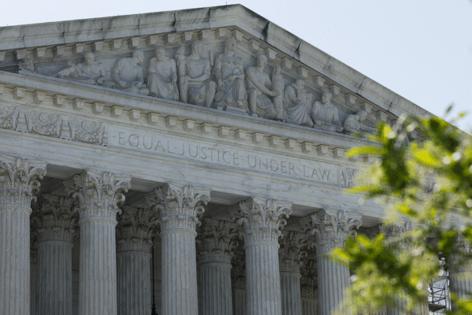Supreme Court allows Trump firings from national labor boards
Published in News & Features
WASHINGTON — The Supreme Court allowed the Trump administration to fire without cause members of the national labor boards for federal employees and workers, despite lower court judges finding that the terminations likely violated federal law.
The unsigned, two-page decision addressed a tangle of lower court orders on the firings of Cathy Harris from the Merit Systems Protection Board and Gwynne Wilcox from the National Labor Relations Board while the cases work their way through the court system.
Congress put in protections that the members cannot be removed except for “inefficiency, neglect of duty, or malfeasance in office.” The majority in Thursday’s decision cited a recent Supreme Court decision upholding the president’s ability to remove federal officials at will, despite laws Congress passed protecting those officials, when those officials wield executive power outside of “narrow exceptions.”
The court’s majority argued that members of the two boards appear to wield “significant executive authority” and the president should presumptively be able to fire them without cause during the legal challenges.
“The stay reflects our judgment that the Government is likely to show that both the NLRB and MSPB exercise considerable executive power,” the unsigned order said.
The Supreme Court order said it is possible that the federal laws protecting Wilcox and Harris from removal are still constitutional, but that would only be decided after the case is finalized.
Although the case does not involve the Federal Reserve Board of Governors, the order argued that the NLRB and MSPB are different from that body and hinted the Federal Reserve board members may have more firing protections.
“The Federal Reserve is a uniquely structured, quasi-private entity that follows in the distinct historical tradition of the First and Second Banks of the United States,” the order said.
The ruling sides with the Trump administration, which has argued that the president should have the power to remove any federal official, regardless of what protections Congress may have put in place against their firing.
Trump officials in January fired Wilcox, who was serving as chair of the National Labor Relations Board, without stating a reason. The firing left the five-member board without a quorum required to function, and Wilcox filed a lawsuit. Similarly, Trump fired Harris, who also filed suit.
Lower court rulings in both cases ordered them reinstated, finding that a federal law protecting those board members from removal was constitutional under a 1935 Supreme Court decision known as Humphrey’s Executor v. United States.
In court filings and letters to Congress, the Trump administration has argued that 1935 decision should be overturned.
Since the initial court ruling in favor of Wilcox and Harris, they’ve been reinstated and fired again multiple times — reinstated by the district courts, allowed to be fired by a panel of U.S. Court of Appeals for the District of Columbia Circuit judges, reinstated again by the full D.C. Circuit.
The Trump administration sought an emergency application to the Supreme Court. As the order was an unsigned emergency order, it was unclear Thursday whether all six of the court’s conservative majority joined the order.
Justice Elena Kagan, in a dissent joined by Justices Sonia Sotomayor and Ketanji Brown Jackson, the court’s two other Democratic appointees, argued that the majority had effectively overturned the 90-year-old precedent on an emergency basis.
“Yet here the President fired the NLRB and MSPB Commissioners in the teeth of Humphrey’s, betting that this Court would acquiesce. And the majority today obliges — without so much as mentioning Humphrey’s,” Kagan wrote.
Congress created independent agencies with “one basic vision,” Kagan wrote.
“It thought that in certain spheres of government, a group of knowledgeable people from both parties — none of whom a President could remove without cause — would make decisions likely to advance the long-term public good,” Kagan wrote.
The dissent criticized the explicit carve-out in the majority opinion for the Federal Reserve as a “bespoke” exception to “reassure the markets” rather than a reasoned decision, Kagan wrote.
The case is Donald J. Trump, President of the United States et al. v. Gwynne A. Wilcox et al.
_____
©2025 CQ-Roll Call, Inc., All Rights Reserved. Visit cqrollcall.com. Distributed by Tribune Content Agency, LLC.







Comments